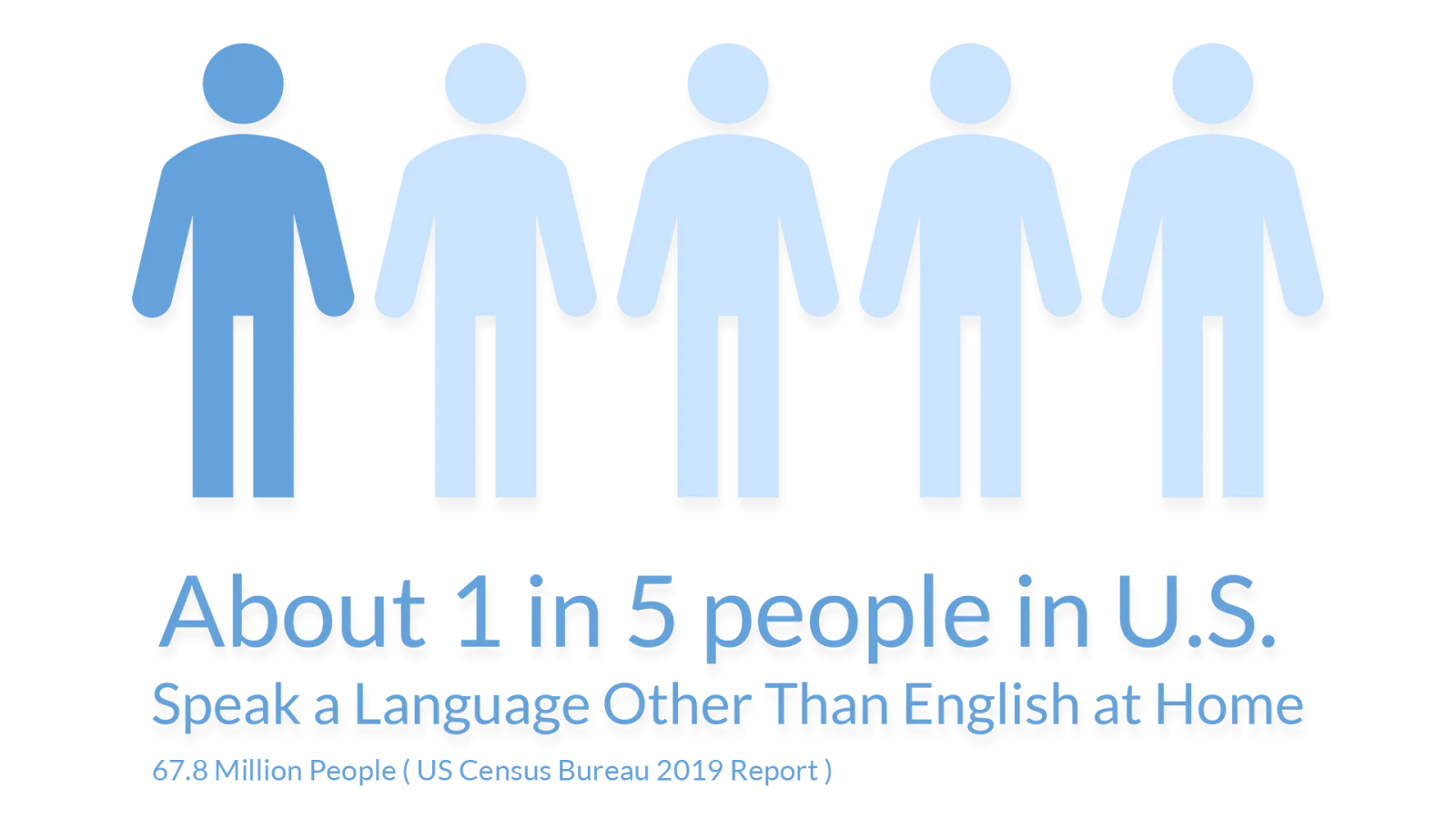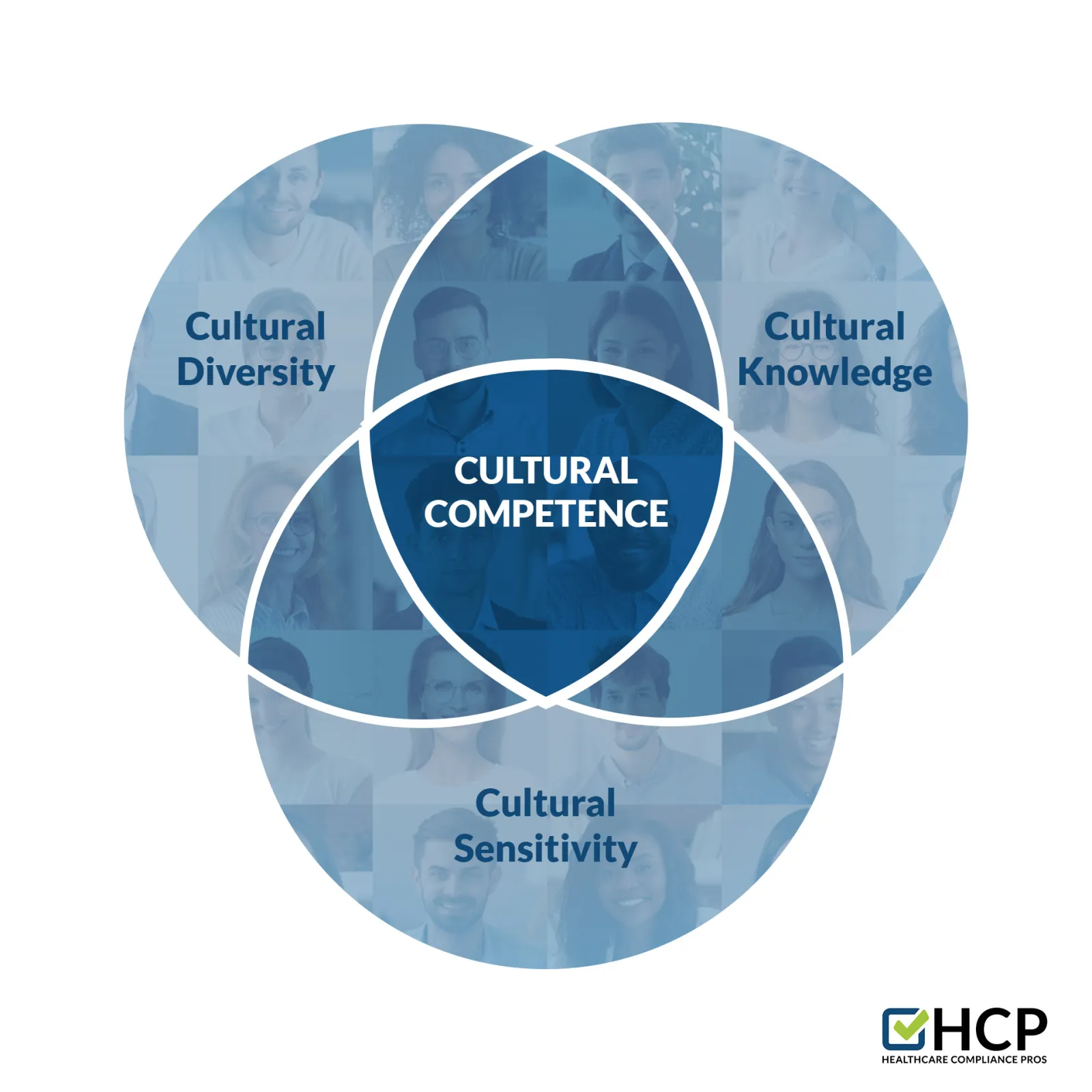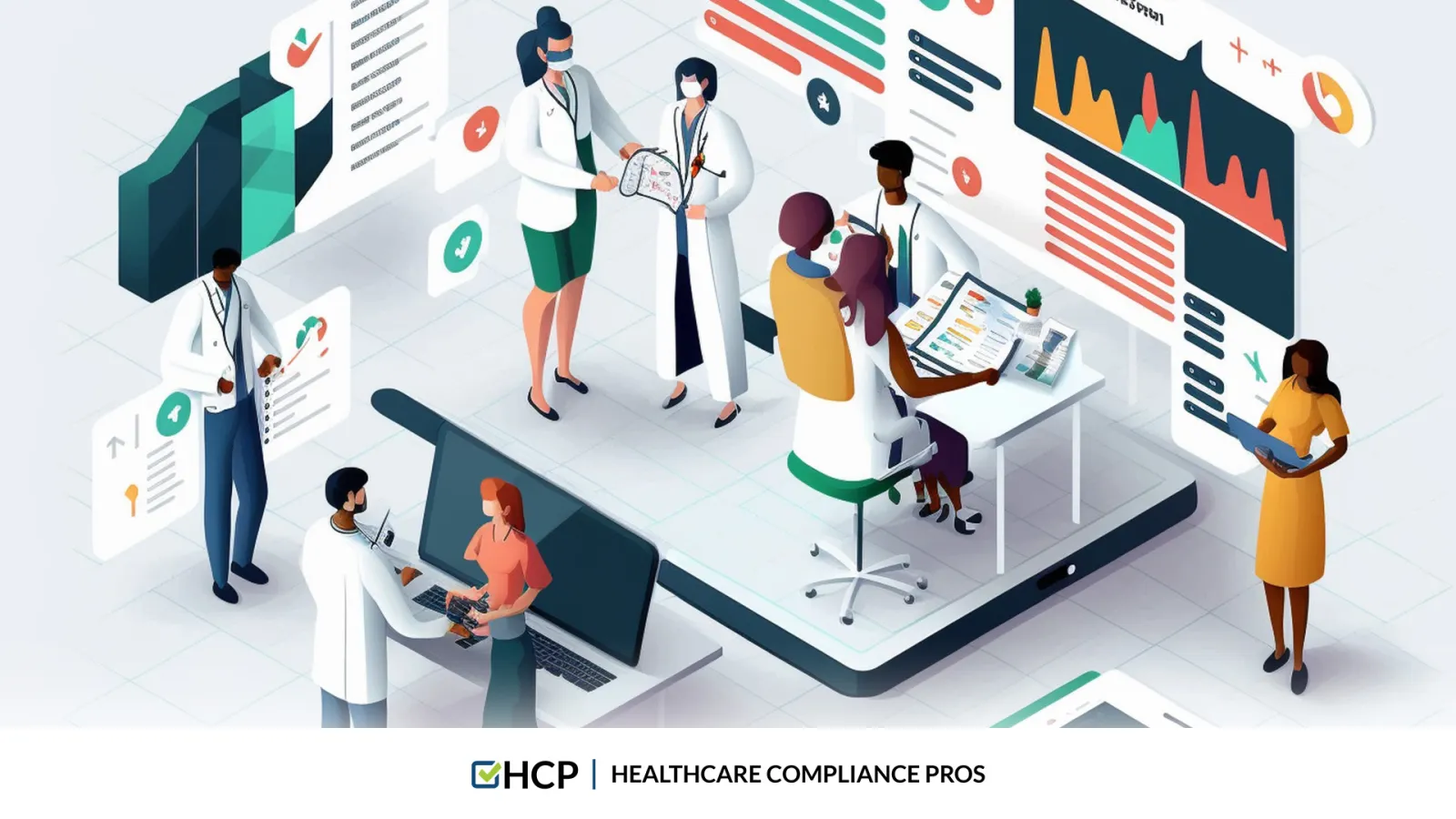Cultural Competency Rules: What Health Providers Must Know Going Forward
JUMP TO THE SECTION
Overview of Cultural Competency
What is Cultural Competence in Healthcare?
Healthcare
workers are pioneering cultural competency. Is it surprising that physicians,
nurses, and other health providers require cultural competence skills? A poor
diagnosis due to provider-patient miscommunication might become fatal or costly to patients, their families, and communities.

The challenge is cultural competency is difficult to measure. At its core, cultural competency analyzes values and attitudes to provide inclusive care. Consider how many HHS.gov agencies must research, document, and enforce diversity requirements (and we'll share those agencies if you keep reading). Our compliance team wants to help you understand and meet your organization's requirements.
This compliance guide outlines key essentials about diversity and cultural competence rules for employees and how to train your staff. The must-have workforce training components include but are not limited to Section 1557 (ACA), National CLAS Guidelines, and two Social Vulnerability Indices (SVIs). In summary, cultural competency requirements aim to promote inclusive care.
What is the Importance of Cultural Competency?
The Biden Administration issued 77 executive orders in 2021, including Executive Order 13985, which is increasing the number of federal regulations and mandates nationwide. In an official response, the "U.S. Department of Health and Human Services Equity Action Plan" (HHS.gov) reveals the post-pandemic objectives and enforcement priorities targetting the entire health sector today.
Public-facing workers across industries are recognizing the need for cultural competence in healthcare training. Covered entities and business associates are seeking to recruit a diverse workforce to function as a compliant organization. Almost 1 in 5 people in the United States speak a language other than English at home (67.8 million individuals), according to a 2019 US Census Bureau report. Did you know this population nearly tripled from 23.1 million people back in 1980 (US Census Bureau)?

What Does Cultural Competency Offer?
Protection. Protects organizations legally and aims to promote efficient healthcare outcomes.
On the individual level, cultural competence offers:
✓ Cross-cultural communications skills;
✓ Providers or translators who speak the clients' language(s);
✓ Strengthened ability to recover from inevitable cultural collisions;
✓ Inclusive decision-making process;
✓ Awareness of cross-cultural differences, beliefs, and values;
✓ Openness to corrective action and good faith practice;
✓ Diversity management skills and leadership commitment.
Understanding Cultural Competence
What is Cultural Health?
"Culture includes knowledge, beliefs, arts, morals, laws, customs, and any other capabilities and habits acquired by a human as a member of society," defines the United Nations Educational, Scientific and Cultural Organization (UNESCO)
Cultural
health is a discipline covering a particular culture's health and accurate
description. The complex study covers both national cultural health and ethnic
cultural health. What are the key differences? National cultural health
studies the health status of individuals across the country. Ethnic cultural
health studies the health status of people within a selected demographic
set or geographic location.
What is Cultural Competency in the Workplace?
"A set of congruent behaviors, attitudes and policies that come together among employees of an organization enabling them to work effectively in cross-cultural situations." defines Cross 1989; Isaacs & Benjamin 1991.
Cultural competence means being
able to communicate with anyone, which requires the following three elements: (1) Cultural Diversity, (2) Cultural Knowledge, and (3)
Cultural Sensitivity. Culturally competent people can acknowledge diversity and
collaborate with others. Policies and procedures can reveal cultural differences
and how an organization serves a community.

Cultural competency
in the workplace means a diversified workforce that reflects society. Diversity
is any trait that distinguishes one person from another (such as visible and
invisible elements). These aspects help firms discover diversity gaps, define
targets, and increase workplace diversity.
The ensemble of HHS agencies, including the Office of Civil Rights (OCR), will be increasing enforcement activity based on the Equity Plan previously mentioned. For a sobering viewpoint, check out the latest HHS enforcement actions of non-compliance, resolution agreements, and civil money penalties.
Expect Greater Scrutiny and Enforcement of Workforce Diversity
For intriguing information, check out
the "Data Visualizations" of enforcement charges documented by
the U.S. Equal Employment Opportunity Commission (EEOC).
Strategically aligning
diversity with operational business goals is highly recommended. Discrimination and poor diversity management have an economic
cost:
- Average EEOC complaint equals about $40,000 settlement and up to approximately $250,000 (depending on organizational size).
- Estimated turnover costs could range between 75% to 150% of a replaced employee's salary (an employer dilemma).
Is achieving and maintaining workforce diversity an economic investment?
Regarding economic and "goodwill branding" capital, perhaps the return on investment
protection outweighs the cost. The anticipated increase in enforcement activity from multiple federal agencies will likely raise the current amount and severity levels of fines.
Training in Cultural Competency (4 Must-Have Elements)
What are the Four Must-Have Elements to Include in Cultural Competency Training?

The following four topics must be included within an effective cultural competency and
diversity training course.
✓ Cross-Cultural Healthcare in the National CLAS Standards
Cross-cultural
healthcare teaches professionals across the country how to
communicate with people from other cultures. Workers, healthcare organizations,
and the public can follow 15 stages to adopt the Nationally Culturally and
Linguistically Appropriate Services (CLAS) Standards.
The CLAS Standard
aims to advance health outcomes, enhance quality, and help eliminate healthcare
disparities. View the complete National CLAS Standards by HHS Think Cultural Health for more
detailed information.
✓ Section
1557 of the Affordable Care Act (ACA)
ACA Section
1557 legally prohibits health discrimination based on race,
color, national origin, sex, age, or handicap. Federally-facilitated
marketplaces and Title I ACA businesses like state-based exchanges are examples
that fall under Section 1557.
Covered entities
include health providers. As the
agency responsible for enforcement, the HHS Office of Civil Rights (OCR)
provided the following statement about the Final Rule:
"There are numerous ways in which health services providers are recipients in their own right, whether the Federal financial assistance they receive comes through certain Medicare payments, Medicaid payments, or other funds from the Department. Therefore, instead of falling outside of Section 1557's purview, many health care providers will be subject to Section 1557 irrespective of their relationship to issuers receiving Federal financial assistance."
✓ Measuring
Social Vulnerability by CDC & OMH
Several factors, including poverty,
limited access to transportation, and crowded housing, can weaken any
community's ability to prevent human suffering and financial loss during a
disaster incident. These factors are known as social vulnerability,
according to the Centers for Disease Control and Prevention (CDC).
1). The Social Vulnerability Index (CDC/ATSDR SVI):
- Developed by the CDC Agency for Toxic Substances and Disease
Registry (ATSDR).
- The SVI aims to enhance existing resources to identify
racial and ethnic minority communities at the most significant risk of
disproportionate impact and adverse outcomes due to the COVID-19 pandemic.
- 16 U.S. Census factors categorize social vulnerability. Keep in
mind this SVI may likely apply to future public health emergencies at the
agency's discretion.
2). The Minority Health Social Vulnerability
Index (Minority Health SVI):
- Co-developed by the CDC/ATSDR and the HHS Office of
Minority Health (OMH).
- The Minority Health SVI uses five-year estimates of
demographic data from the U.S. Census Bureau's American Community Survey (ACS)
and provide an extension of the CDC/ATSDR SVI.
- Collected information organizes into six themes: (1) Socioeconomic
Status, (2) Household Composition and Disability, (3) Minority Status and
Language, (4) Housing Type and Transportation, (5) Health Care Infrastructure
and Access, (6) Medical Vulnerability.
✓ Improving Health
Disparity by CMS
The Centers for Medicare & Medicaid
Services (CMS) state:
"Despite decades of attention and awareness, health care disparities persist across the United States. Racial and Ethnic minorities, people with limited English proficiency (LEP) and low health literacy, sexual and gender minorities and people with disabilities experience worse health outcomes, decreased access to health care services and lower quality of care than the general population."
The socioeconomic status of specific
cultures can affect the health care an individual receives and seeks later. For
instance, those living in impoverished regions may suffer from otherwise
treatable conditions without the availability and affordability of healthcare.
Improving Healthcare Disparities: Building upon the Minority Health and Health Disparities
Research Act of 2000,
the five key areas in the Close the Health Care Gap Act of 2004 focus on helping improve healthcare
disparities:
- Improving quality with better health information technology, performance measurement for federal health programs, and providing incentives;
- Expanding access to work towards providing high-quality health care for low costs;
- Strengthening national efforts and coordination;
- Increasing the diversity of health professionals;
- Conducting research to identify better sources of racial/ethnic, geographic disparities, and access intervention.
These same principles have been under
continuous improvement since the creation of ACA in 2010.

Implementing Cultural Competency into Practice
How to Measure the Effectiveness of Healthcare Cultural Competency?
Cultural Competency Assessment - This specialized
assessment identifies the must-knows for your employees to work more
effectively together. The best scenario? Everyone learns the rules, collaborates
productively, and functions as a team.
An assessment relies on a triangulated approach utilizing archival, interview,
and survey assessments. The results of the different instruments converge to
identify cultural competence gaps.
- Reviewing current documentation, policies, and procedures (Qualitative Data);
- Interviewing key individual informants (Qualitative Data);
- Conducting focus group interviews by demographics (Qualitative Data);
- Conducting an organization-wide survey (Quantitative Data).
How to Implement Cultural Competency Training?
"More than 3 out of 4 job seekers and employees (76%) report a diverse workforce is an important factor when evaluating companies and job offers." (GlassDoor)
Here are seven steps of compliance guidance for covered entities and business associates:

1. Include Diversity and Cultural Competency Training in all new-hire, onboarding training.
2. Conduct refresher training every six months to a year instead of every two years.
3. Discuss diversity in monthly staff meetings and daily conversations.
4. Train physicians, employees, contract workers, and business associates.
5. Hire interpreters, translation services, and care teams with multilingual skills available.
6. Consider based on qualifications when hiring physicians and employees.
7. Track performance along with federal equity outcomes.
What are the Benefits of Diversity and Cultural Competency?
What is the primary value which
summarizes diversity and cultural competence? To strengthen work
environments. Here are some of the benefits to healthcare organizations:
Improving Quality of Care:
- Bringing a variety of skills and experience to the workplace environment.
- Providing multiple perspectives to problem-solving.
- Increasing sensitivity and awareness of diversity and cultural issues.
Increasing Patient Satisfaction:
- Reducing complaints and grievances.
- Achieving higher levels of patient engagement.
- Improving self-reported provider perception and understanding of cultural competency.
Increasing Organizational Efficiency:
- Increasing employee morale and therefore increasing employee retention rates.
- Promoting employee awareness of the tools available to foster a more cohesive workplace.
- Saving financial costs through the reduction of liability issues.
Improving Health Outcomes and Reducing Health Disparities:
- Improving patient-provider communication and patient adherence to treatment.
- Saving costs through improved service delivery and the reduction of costly urgent care costs.
- Providing multiple perspectives to problem-solving. Increasing patient-centered care cost savings due to increased access to appropriate care.
A Recap of Cultural Competency and Compliance Recommendations

In conclusion, this article covered cultural competency in healthcare, its importance, and practical training. Cultural competency is a goal for inclusive care and an HHS requirement to eliminate health inequalities and enhance health outcomes.
The National CLAS Standards, Section 1557 (ACA), and Social Vulnerability Indices were briefly explained (SVI). Ultimately, the themes discussed were about measuring health efforts, the economic value of workforce diversity, and the benefits of cultural competence.
Getting Your Workforce in Trained
Health providers, covered organizations, and business associates need workforce training to avoid costly liabilities and deliver respectful patient care by encouraging an inclusive workplace.
Our
compliance team suggests including Diversity and Cultural Competency course
in new hire training, automated refresher courses, and a diverse workforce (course details).
For examples
of more employee training courses, HCP recommends your learning
management system (LMS) of choice include the following topics:
- View the Diversity & Ethics Series;
- Explore the Behavioral Health Awareness;
- HIPAA Compliance Training Courses;
- OSHA Compliance Training Courses;
- Customize for state and local laws.
Whether you
are a healthcare clinic, provider/facility, or management services organization
(MSO), train your staff regularly to improve productivity and patient care.
Accessing Compliance Resources
Remember that
compliance training alone doesn't mean an organization is fully
compliant, especially with HIPAA, OSHA, Corporate Compliance, Coding &
Billing, and other regulations. If any information shared is unfamiliar or
unclear to you, we recommend consulting with your legal counsel or a compliance
expert.
For HCP
Clients:
- Login into the HCP Portal or contact your dedicated team of compliance advisors for questions.
- Access over 130 training courses.
- CME & CEU Credits available.
If you are not an HCP Client yet, schedule a free consultation to learn about an effective compliance program with management software powered by advisors.
Watch the Free HIPAA Webinar On Demand
View for the educational HIPAA Webinar: "HIPAA Health Data Privacy & The Right of Access"
- Description: There
exists a high-stakes question, 'How to manage Protected Health Information
(PHI)?' Learn essential stories curated by our compliance experts who uphold
PHI requirements within effective HIPAA Compliance Programs nationwide.
- Watch On Demand (No Charge via Zoom).

This information is offered for educational purposes only, and you should not construe this information as legal advice. Specific legal questions regarding these topics should be addressed with one's own counsel.

